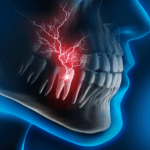Table of Contents
Canines: The Pointed Teeth for Tearing and Gripping
Canines, also known as cuspids or fangs, are the pointed teeth located at the corners of our mouths. These sharp teeth play a crucial role in tearing and gripping food. In the evolutionary context, canines were developed to help our ancestors tear apart meat and other tough foods effectively. Their pointed shape and robust structure make them ideal for piercing and holding onto food, facilitating the initial stages of digestion.
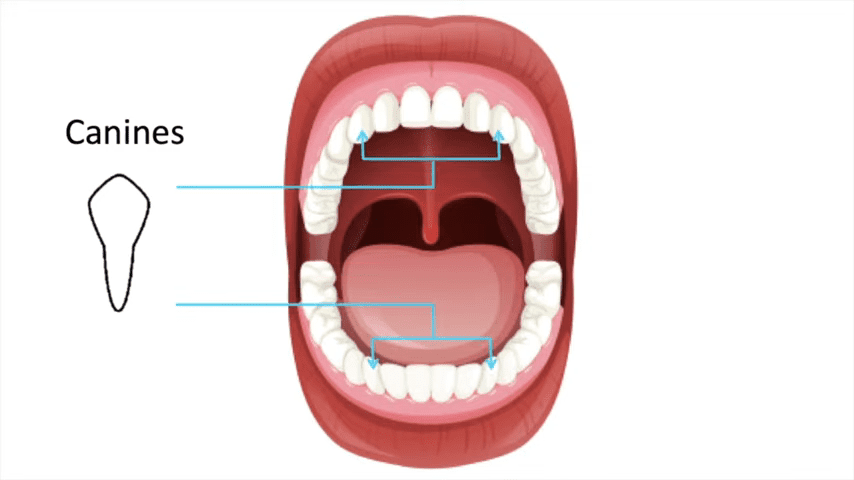
The importance of canines in chewing cannot be understated. Although we no longer rely solely on tearing meat like our ancestors, canines remain essential for tearing through food that requires a bit of extra force, such as fibrous vegetables or dense grains. The gripping function of canines is particularly evident when handling items like apples or carrot sticks, where the pointed tips help secure the food for efficient chewing.
Premolars: The Teeth for Chewing and Grinding
Premolars play a pivotal role in the intricate process of chewing and grinding food within the oral cavity. Situated behind the canines, these dual-purpose teeth are designed to crush and shear food particles into smaller, more digestible pieces. Their flat, broad surfaces are adept at breaking down tougher textures and facilitating the initial stages of mechanical digestion. By working in tandem with the incisors and canines, premolars contribute significantly to the efficient mastication of food before it progresses further along the digestive tract.
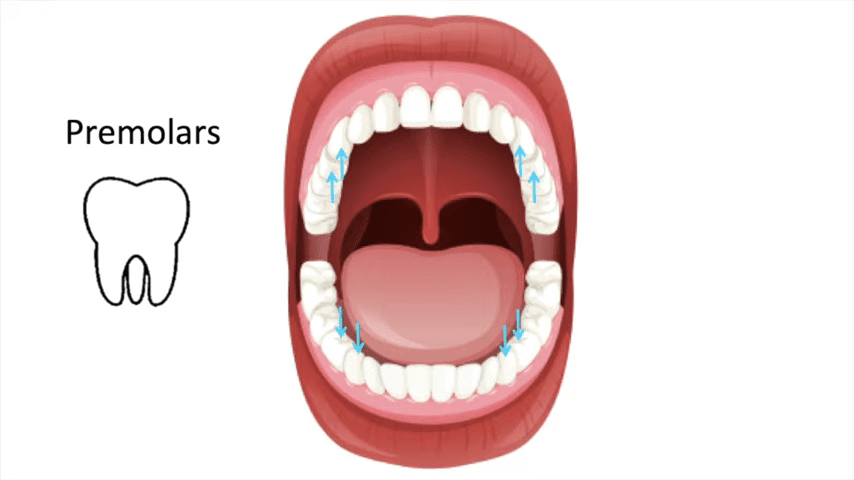
Moreover, the precise alignment and interplay of premolars within the dental arch are essential for maintaining proper occlusion and ensuring the even distribution of bite forces during chewing. As the transitional teeth between the pointed canines and the robust molars, premolars bridge the gap between tearing and crushing functions, underscoring their importance in the overall oral health and digestive processes. Dentally speaking, these versatile teeth serve as crucial intermediaries that facilitate the breakdown of various food textures, emphasizing the significance of their anatomical structure and functional contribution to the dental system.
Molars: The Back Teeth for Crushing and Mashing
Molars, the large and flat back teeth, play a crucial role in the chewing process by crushing and mashing food into smaller, more digestible particles. Positioned at the rear of the mouth, these powerhouse teeth are designed to withstand substantial pressure and are essential for breaking down tough or hard foods, such as nuts, seeds, and fibrous vegetables. With their broad surface area and sturdy structure, molars efficiently grind food to facilitate proper digestion and nutrient absorption.
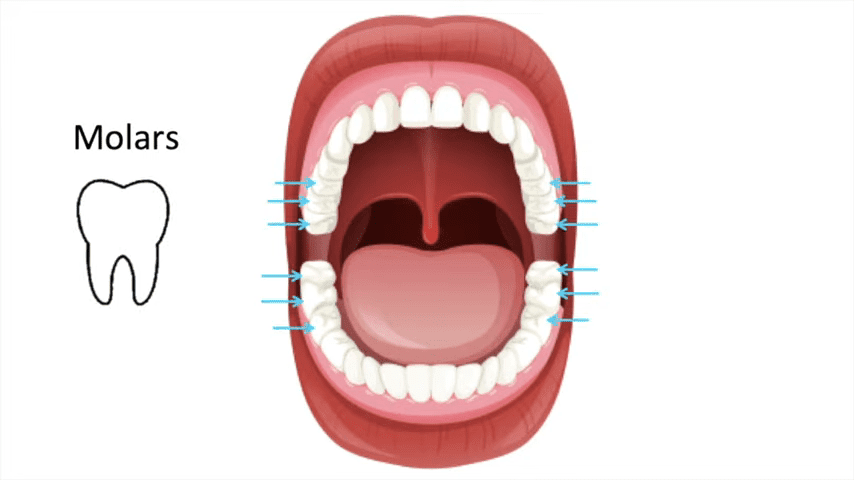
Due to their strategic placement and function, molars contribute significantly to overall oral health and well-being. By thoroughly pulverizing food particles, they aid in the initial stages of digestion and help prevent larger chunks from causing issues further down the digestive tract. Additionally, the intricate ridges and grooves on the surfaces of molars enhance their effectiveness in grinding, ensuring that nutrients are extracted efficiently during the digestive process. These powerhouse teeth exemplify the intricate design of the human dentition and the harmonious interplay between different types of teeth to support optimal oral function and overall health.
Enamel: The Strong Outer Layer of Teeth
Enamel serves as the robust external layer of our teeth, providing crucial protection and strength. Comprised largely of minerals, primarily hydroxyapatite, enamel is the hardest substance in the human body, even tougher than bone. Its dense structure shields the inner layers of the tooth from decay and damage caused by chewing, biting, and various external factors. Enamel’s durability and resilience are essential for maintaining the integrity of the teeth, ensuring their functionality and longevity.
Given its vital role in safeguarding the teeth, the wear and tear on enamel over time can compromise oral health. Factors such as acidic foods, poor oral hygiene practices, and teeth grinding can erode enamel, leading to sensitivity, discoloration, and increased susceptibility to cavities. Therefore, protecting enamel through regular dental check-ups, proper brushing techniques, and a balanced diet is imperative for preserving overall dental well-being. Ultimately, understanding the significance of enamel underscores the importance of maintaining good oral habits to uphold the strength and integrity of our teeth.
Dentin: The Hard Tissue Beneath the Enamel
Dentin is a crucial component of our teeth, situated beneath the protective layer of enamel. It is a dense, bonelike tissue that provides support and structure to the tooth. Composed of microscopic tubules filled with fluid, dentin plays a vital role in transmitting stimuli to the nerves within the pulp of the tooth. This innervated tissue aids in sensing temperature changes, pressure, and other external stimuli, contributing to our overall sensory experience during chewing and consuming food.
Moreover, dentin serves as a cushioning layer for the sensitive inner pulp, guarding it against external aggressors. When the enamel is compromised due to decay or damage, dentin acts as a resilient barrier, preventing harmful bacteria and irritants from reaching the delicate nerve endings within the tooth. Understanding the significance of dentin sheds light on the intricate design of our teeth and emphasizes the importance of maintaining proper dental hygiene to safeguard this pivotal layer of our dental anatomy.
Pulp: The Innermost Part of the Tooth
The pulp, situated at the very core of a tooth, plays a crucial role in maintaining its health and vitality. Comprised of a delicate network of nerves, blood vessels, and connective tissues, the pulp serves as the lifeline of the tooth, supplying essential nutrients and oxygen to sustain its function. Additionally, the pulp also serves as a sensory organ, facilitating the perception of stimuli such as temperature, pressure, and pain. Any damage or infection to the pulp can lead to severe pain and discomfort, necessitating timely intervention to preserve the tooth’s integrity and prevent further complications.
When the pulp becomes inflamed or infected due to factors like deep decay, trauma, or repeated dental procedures, root canal therapy is often recommended to save the tooth. During this procedure, the diseased pulp is carefully removed, and the inner chamber is cleaned, disinfected, and sealed to prevent reinfection. While the idea of a root canal may evoke apprehension in some individuals, modern advancements in dental technology and techniques have made the procedure more comfortable and efficient, ensuring the preservation of natural teeth and restoration of oral health.
Roots: Anchoring Teeth in the Jawbone
The roots of teeth play a crucial role in anchoring them securely in the jawbone, providing stability and support for chewing and biting activities. Each tooth is firmly held in place by one or more roots that extend into the jawbone, ensuring that the tooth remains in its proper position during the forces exerted while eating and speaking. The roots also serve as a conduit for nerves and blood vessels that supply the tooth with essential nutrients and sensations.
The number of roots can vary depending on the type of tooth, with some teeth having a single root while others, like molars, can have multiple roots. The shape and length of the roots are also tailored to the specific function and location of the tooth in the mouth. Maintaining healthy roots is crucial for overall dental health, as any damage or infection to the roots can lead to discomfort, mobility, and even tooth loss if left untreated. Regular dental check-ups and proper oral hygiene practices are essential in preserving the integrity of the roots and ensuring the longevity of the teeth.
Gums: Supporting and Protecting the Teeth
The gums play a crucial role in supporting and protecting our teeth. They serve as a barrier that helps to keep harmful bacteria at bay, reducing the risk of infection and other oral health issues. Healthy gums are essential for maintaining the stability of our teeth by securely anchoring them in place within the jawbone. Additionally, the gums provide a protective cushion around the base of each tooth, shielding the sensitive root and surrounding structures from damage or injury.
Proper oral hygiene practices, such as regular brushing and flossing, are necessary to keep the gums healthy. Neglecting gum care can lead to conditions like gingivitis and periodontitis, which can cause inflammation, bleeding, and eventual tooth loss if left untreated. Regular dental check-ups and cleanings are also crucial in monitoring the health of your gums and catching any issues early on. Remember, healthy gums are the foundation for a strong and vibrant smile.
Periodontal Ligament: Attaching Teeth to the Jawbone
The periodontal ligament plays a crucial role in oral health by attaching teeth to the jawbone. This fibrous connective tissue provides support and stability to the teeth, allowing for the necessary movement during chewing and speaking. It acts as a cushion, absorbing the forces exerted on the teeth during various activities, thereby protecting the surrounding structures from excessive pressure and damage. Additionally, the periodontal ligament acts as a sensory organ, providing feedback to the brain about biting and chewing forces, contributing to the overall coordination of oral functions.
Maintaining the health of the periodontal ligament is essential for preserving the integrity of the teeth and supporting structures. Proper oral hygiene practices, such as regular brushing, flossing, and dental check-ups, help prevent periodontal diseases that can compromise the function of this crucial ligament. In cases of injury or disease affecting the periodontal ligament, timely intervention by dental professionals is necessary to prevent tooth mobility and potential tooth loss. Understanding the significance of the periodontal ligament underscores the importance of comprehensive oral care in promoting long-term dental health and function.
Crown: The Visible Part of the Tooth Above the Gums
The crown of a tooth is the visible part that sits above the gums. It is crucial in protecting the sensitive inner layers of the tooth, such as the dentin and pulp, from external elements and damage. The enamel, which is the hardest substance in the human body, covers the crown, providing a strong protective layer against wear and tear from chewing, biting, and other daily activities.
Additionally, the shape and alignment of the crown play a significant role in maintaining proper bite and alignment of the teeth. Any abnormalities or irregularities in the crown can lead to issues with chewing, speaking, and overall oral health. Regular check-ups with a dentist can help in identifying any potential problems with the crown early on, allowing for prompt intervention and treatment to preserve the health and functionality of the tooth.
Neck: The Area where the Crown and Root Meet
The neck of a tooth is the crucial juncture where the visible crown meets the hidden root beneath the gum line. This transitional area plays a pivotal role in anchoring the tooth securely within the jawbone, ensuring stability for essential functions like biting and chewing. The neck’s structure is designed to support the entire tooth, providing a seamless connection between the crown’s enamel – the protective outer layer – and the root’s supportive tissues. Understanding the significance of the neck in dental health underscores the importance of proper oral hygiene to maintain the integrity of this critical junction.
Maintaining the health of the neck area is fundamental in preserving the overall well-being of the tooth. Any issues affecting the neck, such as decay or gum disease, can compromise the tooth’s stability and lead to discomfort or potential tooth loss. Regular dental check-ups and diligent oral care habits are imperative in safeguarding the neck region from detrimental conditions that could jeopardize the tooth’s structural integrity. By acknowledging the pivotal role of the neck in dental anatomy, individuals can prioritize preventive measures to safeguard this vital connection between the crown and root, ensuring optimal oral health and function.
Incisor Function and Importance in Chewing
Incisors play a vital role in the chewing process, as they are responsible for biting into and cutting food into manageable pieces. Positioned at the front of the mouth, these flat-edged teeth are crucial for the initial breakdown of food before it moves on to the molars and premolars for further grinding and crushing. Their sharp edges help in slicing through food with precision, facilitating efficient mastication and digestion.
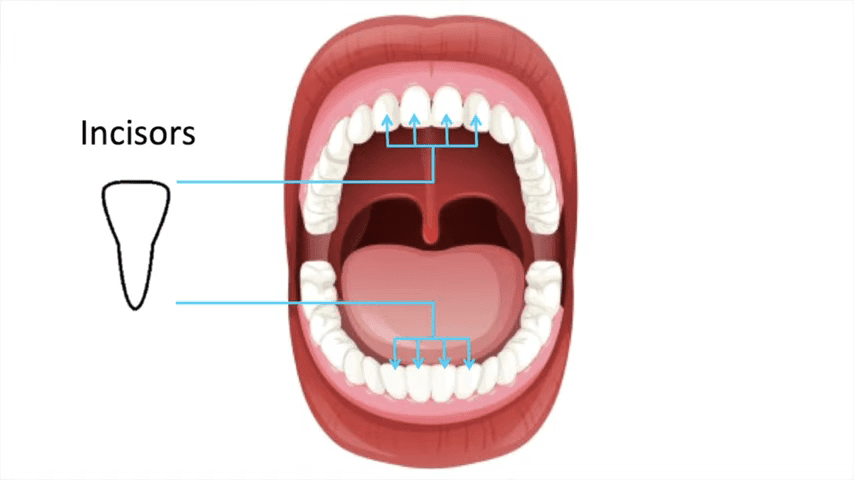
Apart from their primary function in chewing, incisors also contribute to the overall aesthetics of a smile. These teeth are prominently visible when a person speaks or smiles, and their health and appearance play a significant role in overall facial aesthetics. Ensuring proper care and maintenance of incisors is essential not only for oral health but also for a confident and appealing smile.
Canine Function and Importance in Tearing Meat
The canine teeth, also known as the pointed teeth, play a crucial role in tearing and gripping meat during the chewing process. Positioned strategically at the corners of the dental arches, canines are designed to pierce and hold onto food, particularly meat, allowing for efficient tearing and reducing the size of food particles for easier digestion. These sharp and pointed teeth are essential for carnivorous animals for hunting and consuming prey, showcasing their importance in the carnivorous diet.
In addition to their functional role in tearing meat, canine teeth also contribute to the aesthetic appeal of a smile by helping to maintain the shape and alignment of the dental arches. The strong and pointed structure of canines provides support and stability to the neighboring teeth, aiding in proper chewing and preventing misalignment issues that can result from uneven pressure distribution during the chewing process. Overall, the canine teeth serve a dual purpose of both functional efficiency in tearing meat and structural integrity in maintaining a healthy and balanced dental arch.
Premolar Function and Importance in Grinding Food
Premolars play a crucial role in the process of grinding food during mastication. Located behind the canines, these teeth are designed with flatter surfaces and multiple cusps that aid in breaking down food particles into smaller, more manageable pieces. The premolars’ complex structure and arrangement allow for efficient crushing and grinding of food, facilitating the digestive process and ensuring effective nutrient absorption.
| Premolar Function | Importance in Grinding Foods |
|---|---|
| 1. Crushing and grinding food into smaller pieces | Premolars play a crucial role in breaking down food particles into smaller fragments, aiding in the initial stages of digestion. |
| 2. Initiating mechanical breakdown of food | They help initiate the mechanical breakdown of food, preparing it for further digestion by enzymes in the stomach and small intestine. |
| 3. Assisting in mastication | Premolars aid in the process of chewing (mastication), which helps mix food with saliva, facilitating swallowing and digestion. |
| 4. Distributing forces evenly across the teeth | They distribute the forces generated during chewing evenly across the dental arch, reducing the risk of damage to individual teeth and ensuring efficient food processing. |
| 5. Supporting overall oral health | Proper functioning premolars contribute to overall oral health by maintaining the integrity of the dental arch and promoting effective mastication, which aids in nutrient absorption and digestive processes. |
The importance of premolars in grinding food cannot be overstated in maintaining overall oral health. By thoroughly breaking down food into smaller fragments, premolars help prevent potential issues such as choking hazards or improper digestion. Additionally, the efficient grinding function of premolars contributes to better oral hygiene by reducing the likelihood of food particles getting stuck between teeth and leading to decay or gum disease. Proper care and regular dental check-ups are essential to ensure the optimal function of premolars in grinding food effectively and maintaining a healthy smile.
Molar Function and Importance in Crushing Hard Foods
Molars play a crucial role in the process of crushing and mashing hard foods during chewing. These large, flat teeth are located at the back of the mouth and are specifically designed to grind down food into smaller, more manageable pieces. Their broad surface area and sturdy structure allow them to exert significant pressure, making them instrumental in breaking down tough and fibrous foods like nuts, seeds, and raw vegetables. The molars work in conjunction with the premolars and canines to ensure that food is thoroughly processed before swallowing, aiding in efficient digestion and nutrient absorption.
The importance of molars in crushing hard foods cannot be overstated, as they contribute significantly to the initial stage of digestion. Their ability to grind food into a semi-liquid consistency prepares it for further breakdown in the stomach and intestines, facilitating the extraction of essential nutrients. Maintaining the health and function of molars is essential for overall oral health and proper nutrition. Regular dental check-ups, proper oral hygiene practices, and a balanced diet can help preserve the integrity of molars and ensure optimal chewing efficiency for a lifetime of healthy eating.
How do molars function in crushing hard foods?
Molars are the back teeth that have flat surfaces designed for crushing and mashing tough foods such as nuts, seeds, and tough meats.
Why are molars important in the chewing process?
Molars play a crucial role in breaking down hard foods into smaller, more manageable pieces that can be easily swallowed and digested.
Can molars withstand the pressure of crushing hard foods?
Yes, molars are equipped with strong enamel and dentin layers that enable them to withstand the pressure of crushing hard foods without getting damaged.
What is the significance of proper molar function in overall oral health?
Proper molar function is essential for maintaining good oral health, as it ensures efficient chewing and digestion of food, which helps prevent issues such as indigestion and malnutrition.




